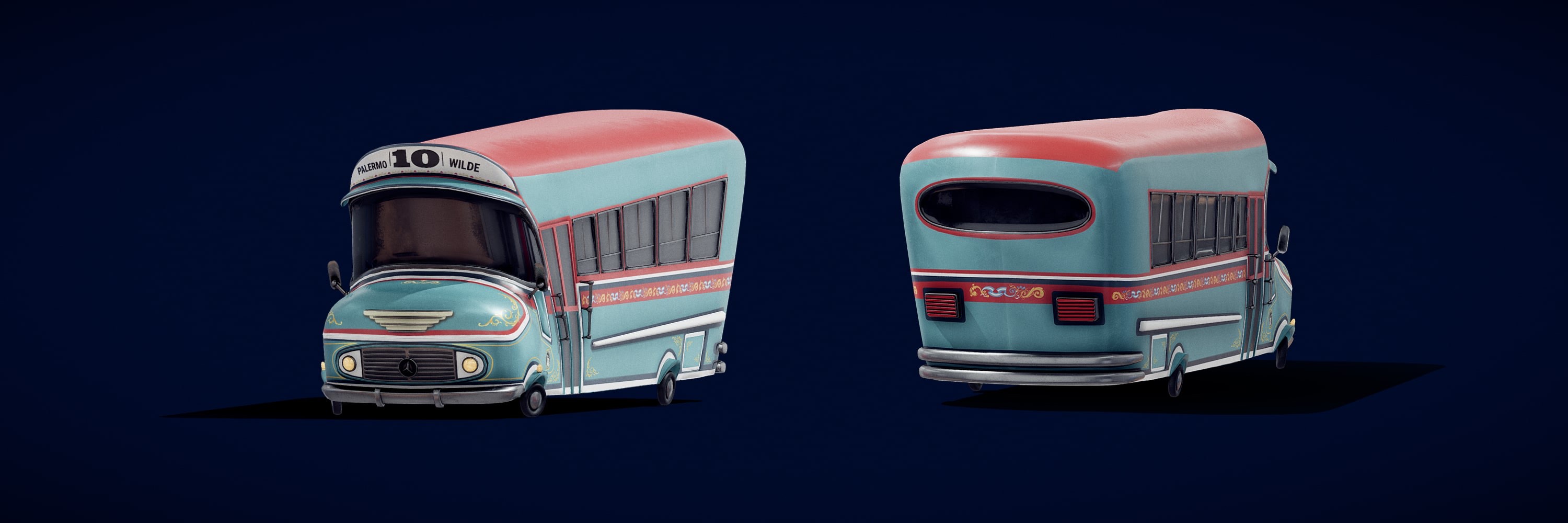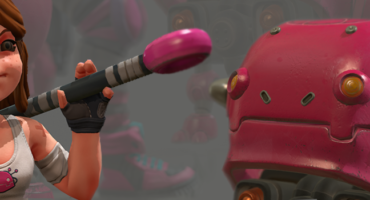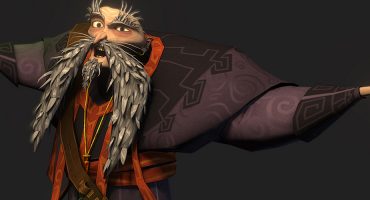About Me
My name is Mauricio Sanjurjo and I’m a Graphics Designer who works on Motion Graphics and UI/UX design, but my real passion is 3D modeling. I don’t have any formal training on this discipline, so I’ve learnt my craft via experimentation and attending a wide range of online courses. My first real world experience was a few years ago, when I created all the 3D models and static renders of the strategy game Buzz Aldrin’s Space Program Manager. I’m currently working on the 3D models and the UI/UX design of Space Station Designer, which is under heavy development. You can find some of my work on Sketchfab, my Portfolio, and my Instagram account.
Research for Colectivo 10 Toon (Argentine Bus)
Colectivo 10 is a personal project based on an idea that I had been toying around with for quite a long time. Actually, now that I think about, the seed for this project probably started sometime during my childhood! Back then, thousands of Mercedes-Benz LO 1112 public buses (commonly referred to as “bondis” in Argentinian slang) used to roam the streets of my native Buenos Aires. Every time I looked at them, I couldn’t help myself seeing them as living creatures, since the combination of their noses, their windshields, and their wipers definitely brought them to life.
 Mercedes-Benz LO 1112 model from 1969, currently in display at the Mercedes-Benz Museum in Stuttgart, Germany (source: Wikipedia).
Mercedes-Benz LO 1112 model from 1969, currently in display at the Mercedes-Benz Museum in Stuttgart, Germany (source: Wikipedia).One of my goals with this project was to exaggerate the aspects of these types of buses, but without leaving aside the native aspects that make them so unique. So I started investigating an artistic style born in Buenos Aires towards the end of the 19th century named “Fileteado porteño”, which has strong connections with Tango, a partner dance born around that time. During my research, I came across an endless amount of reference images from various great local artists, such as Alfredo Genovese and Martiniano Arce.
 Signs featuring the fileteado technique on display at the Abasto neighbourhood in Buenos Aires (source: Wikipedia).
Signs featuring the fileteado technique on display at the Abasto neighbourhood in Buenos Aires (source: Wikipedia).Another important goal for this project was to adopt a cartoonish style (a style that I personally love), heavily influenced by cartoons such as “The Jetsons”, and the short episode “The Car of Tomorrow” directed by Tex Avery. Other modern influences include the excellent work from Paul McMahon.
 “On the Run”, by Paul McMahon (source: ArtStation).
“On the Run”, by Paul McMahon (source: ArtStation).The 3D Model
Every project needs to adopt a workflow according to its target goal. In this case, I didn’t have a specific goal in mind… other than uploading the model to Sketchfab at some point for everyone to enjoy. 🙂
I started by using 3ds Max to generate a high-poly 3D model that imitated the distinctive features of the vehicle, with a large emphasis on its “dog nose”. After that, I started playing around by stretching and deforming the model until I managed to find a morphology that felt right. This was one of the most enjoyable phases of this project, as everything was achieved via trial and error and without imposing too many technical restrictions upon myself.
Once I was satisfied with its morphology, I began to retopologize it. Generally this is a task that I don’t particularly enjoy, because more often than not I have to work with low-poly models and I have to prioritize technical requirements over aesthetic ones. For this particular project, though, I had no technical restrictions when it came to polycount, so it wasn’t really an issue!
Once I finished the low-poly version of the model, I had to make some technical decisions regarding the next steps, such as the number of textures I was planning to use, or whether I should reduce the overall number of textures by taking into account that the model is symmetrical.
In the end, I decided to create two sets of textures. The first one was going to feature only the main parts of the bus’ body, whereas the second one was going to be used for the window frames, the lights, the wheels, and the mirrors. I then created two separate materials so that I could create a unique UVW set per material in Substance Painter.
Painting Time!
Using Substance Painter, I baked the high-poly model over the low-poly one in order to get some extra details such as texture normals and ambient occlusion. In order to create the textures, I used some ‘painted metal’ predefined materials as a starting point. I then embarked into another trial and error process, where I applied masks across certain areas of the texture in order to separate the colours. I didn’t follow a particular reference image during this process, as the whole goal was to create a texture that imitated the style I was aiming for.
After the basics were in place, I came across the first major hurdle when generating the final details of the texture. More specifically, I found that the “fileteado” technique was very hard to replicate!
I like to dive deep and learn techniques that I’ve never used before and, without a doubt, this was one of those instances. I first tried to create the “fileteado” on paper, but I wasn’t really happy with the results. I then tried to use a digital tablet instead and, even though the results started to look more promising (as I had a finer control over color separation), I was still unable to achieve the same level of quality seen in the works made by more experienced artists.
Before giving up on this, I realised I should put a lot more hours of practice into this technique. So I decided to shift my focus into something smaller and, more importantly, used a tool that gave me the right amount of control.
Using an endless amount of reference images, I started to generate the ‘fileteados’ using vector images instead of bitmaps. This decision was deliberate, as I knew that some information was going to be lost during the texturing process, but the core elements behind the “fileteado” would still be there. I then projected several “filetes” in stencil mode next to each other in order to generate some sort of continuity.
To wrap this phase up, I added and corrected some details over the model itself, such as the yellow lines seen in the front, by using a very fine brush.
Moving on to Sketchfab
The final scene setup is very important to reach a high level of quality, and I knew that it definitely had to reinforce my goal of achieving a cartoony style. I started tweaking the field of view and, after some experimentation, I settled for the lowest value required in order to achieve an orthogonal view. I also selected the “Render PBR” option.
The rest of the scene setup process was very straightforward: I ensured that the model was well lit, featuring an even distribution of light. I also used the “Industrial Room” option as HDRI, which helped me achieve a stronger illumination in certain areas.
Regarding materials, I left the various parameters for them untouched. The rest of the details were achieved by using various post-processing effects. In my opinion, the usage of tone mapping really helped to achieve a “filmic” effect, which helped compensate the light intensity and the exposure. This allowed me to produce a well-illuminated model, while still keeping control of the overall light.
Hope you enjoyed this overview of Colectivo 10 Toon! Let me know what you think about it in the comments, along with any feedback you might have about the techniques I’ve used.











